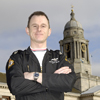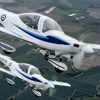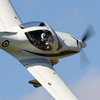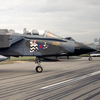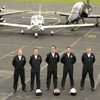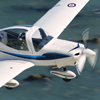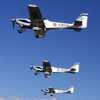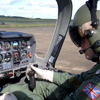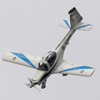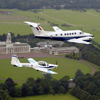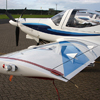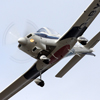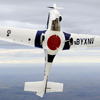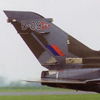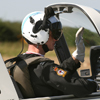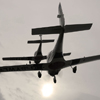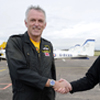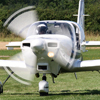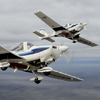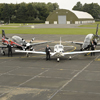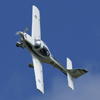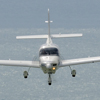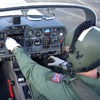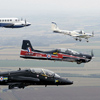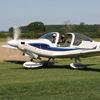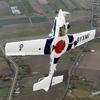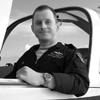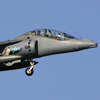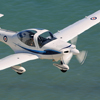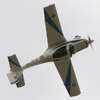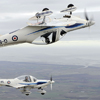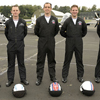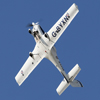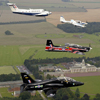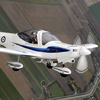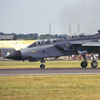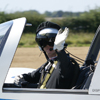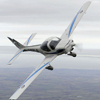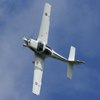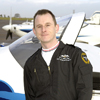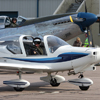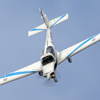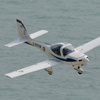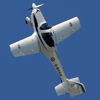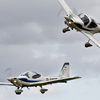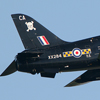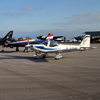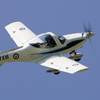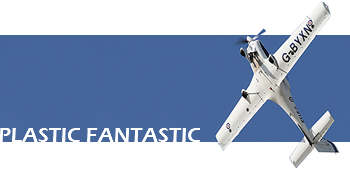
RAF Tutor Display Feature Report
Sunday 14th December
It's sometime during the 1970s. The venue is Shobdon Airshow. I am buried in the foot-well of my ex-RAF Grandfather's Ford Escort. He is outside, adoring every second of the spectacle that is unravelling before him. The RAF Lightning is finishing off its display routine with a zoom climb to the stratosphere. For the last five minutes I have been absolutely terrified as this monstrous machine has roared around the skies, ripping up the air with its reheat. Now, some thirty something years later, the airfield at Abingdon is packed with spectators. This time it is me diving towards the crowd line at just over 200mph, about to pull up vertically to commence a display of my own...
provides a look back at his time as the 2007/8 RAF Tutor Display Pilot in this UKAR exclusive and how he ended up there to start with. Photography as credited.
I joined the RAF in 1991, initially as a navigator and after training was posted to the Tornado GR1. My first tour was a thoroughly enjoyable three years with 17(F) Squadron at RAF Brüggen in Germany. Whilst there, during a two week break over the Christmas of 1996, I embarked on my PPL. I was extremely lucky with the weather and managed to complete the whole course in the two weeks. After Brüggen I was posted to RAF Cottesmore to be an instructor at the Tri National Tornado Training Establishment (TTTE) or Thomas the Tank Engine as it was affectionately known. I taught RAF, GAF and IAF student pilots and navigators how to operate the Tornado. I had always been a frustrated front seater at heart; I had missed the maximum entry age for pilot by about six months.
My lucky break came early in 1999 when I was selected to take part in a trial to convert navigators to pilots. My first sortie as a student pilot soon followed and I got the chance to finally experience life in the front seat of the Tornado GR1. I flew the Hawk, Tucano and eventually the mighty Harrier T10 and GR7. My last tour was again flying the Hawk, this time at 100 Squadron at RAF Leeming. Part of their job is to provide student navigators with their advanced flying training. I took up the role as a Qualified Pilot Navigator Instructor, or as some would say 'poacher turned gamekeeper!' Coming to the end of my tour and indeed my time in the RAF, I was asked if I had ever considered a job with the University Air Squadrons flying the Tutor. “The what?”, I replied.
After signing on the dotted line for a further two years service, I was whisked off to RAF Cranwell to begin life as a Qualified Flying Instructor (QFI) flying the mighty Tutor! Flying the Tutor was a bit of a shock to the system after 13 years of life on fast jets. Suddenly I was in a machine with less power than my car and with a roll rate best measured with a calendar rather than a stopwatch. That said, for a two seat “puddle jumper” it is an extremely good machine, great for ab-initio flying training. You really appreciate it when you climb out of it into something like the venerable Cessna 152. Approaching the end of 2006, the trawl was on to find the RAF Tutor Display Pilot for 2007; I was at the front of the queue where I had been camped out for much of the year!
Every bit of spare time I had whilst flying (very precious these days) was spent practicing my aerobatics. I read numerous books on the subject and developed a sequence that I could hone and perfect. I was absolutely determined to get the job; I had always wanted to be a display pilot. The shortlist was announced, three QFIs, one from each Elementary Flying Training School (EFTS) and I was on the list as the representative from 1 Squadron 1EFTS. The final “fly off” was to take place with the Officer Commanding, Group Captain 1EFTS. The competition required each candidate to fly an aerobatic sequence (not necessarily the eventual display) of at least five minutes and to a nominated minimum height. Judgement day arrived and the skies were not looking good! Someone was looking after me though, the only hole in the clouds was overhead Barkston Heath, the perfect feature over which to fly my sequence. Six minutes later, after every manoeuvre I could think of, my future lay in the hands of a now rather dishevelled Group Captain. Luckily there is no waiting around after the competition, the winner was announced. It was me!
I was to be the RAF Tutor Display Pilot in 2007; it was now October 2006 so I had plenty of time to design the new display. “Right, I'll start with a Lomcevak, into an outside loop, several gyroscopic manoeuvres, a rolling circle ………..”. Reality strikes fairly quickly with the Tutor. Now, for a small aeroplane, the Tutor is actually very capable but, only in small bursts or if you accept a height loss. So, the display can either start high and work down, or start low and be fairly benign. The Tutor is never going to be a show stopper; it's quiet, slow and doesn't have a lot of visual impact. What it does have going for it however, is that it is very manoeuvrable and so the display can be very tight with something always happening. Also, it is fully capable of flying in cloud (IMC), something none of the civilian aerobatic aircraft are capable of, hence why the Tutor is often present on those typical English summer days.
The RAF, as a whole, possesses very little experience of advanced light aircraft display aerobatics. Luckily I had Charlie Brown next door to corner occasionally. Most incoming display pilots rely on the previous year's pilot for advice. I took a different avenue myself in the form of Alan Wade, the DEFTS Firefly Display Pilot. Unfortunately all too seldom seen on the display circuit, his is one display to look out for. Alan has been a professional display pilot for many years and very kindly gave me some absolutely priceless advice. I was also lucky enough to spend a few hours airborne with him to hopefully absorb some of his skills. The end result was my sequence ending up in the bin and between us we came up with the 2007 sequence. The whole aim was to be a graceful display, demonstrating energy management but punctuated with surprise manoeuvres to show what the aircraft is capable of. To get around the height loss problem, I actually started the display by diving down to maximum speed before pulling up vertically thus converting all my kinetic energy into potential energy. By trading height for speed and vice versa I could carry the aircraft through the six and a half minute display with energy in hand throughout. The aircraft has a very poor roll rate, but help came in the form of the flick roll which featured quite heavily throughout my display, it looks more impressive than a conventional roll too.
The work up (I always thought it should be work down) for the season started in February of 2006. I had to fly consecutive supervised practices, six at 3000', six at 1500', six at 1000' and six at 500' before being signed off to practice at display height. Each practice is filmed and is always viewed by the display supervisor standing outside the control tower. The film is watched very closely to analyse every part of the display to see how each manoeuvre can be improved or differently presented. It's always quite reassuring and sometimes sobering to see the manned fire vehicles standing by for if the unfortunate should happen. It is really quite something to be pointing vertically down with a face full of ground at low level for the first time! The final hurdle is the Public Display Authority held in April, which is effectively your licence to display in front of the public. My first public display was at Abingdon at the start of May 2007 and the season continued through to the end of September at Southport. It is a busy year occupying virtually every weekend and a lot of weekdays through the height of summer. During the rest of the week my full time job was still as a QFI at Cranwell.
The aircraft is pre-positioned for most shows, normally last thing on a Friday ready for the Saturday display. Sometimes however, this is not practical, especially when doing multiple displays on the same day. The day could end up being quite long, for example; Aug 16 2007. I took off from Cranwell early morning and flew south, landing at Shoreham 1hr 50mins later (It was a very windy day!). I displayed at Eastbourne, a 45min round trip to Shoreham. Next event was Dawlish Carnival landing at Exeter for fuel, 1hr 30mins. Next, returning to Shoreham ready for the next show - 1hr. Finally, the last leg, a 2hr car journey - through the road works and holiday traffic - to arrive at Eastbourne. If you have never sat in a Tutor, I can assure you that 5hrs+ is not the most comfortable! I must admit wishing I was back in a fast jet for the transit sorties. Interestingly, it was often the transits between the airshows that proved to be some of the most challenging flying. The “summer” weather that we have had in recent years has proved extremely difficult at times, torrential rain, strong winds and thunderstorms all playing their hand. A long transit through poor weather to get to an airshow to then perform an aerobatic routine focuses the mind somewhat.
Running in towards the crowd for the first pull up, I can actually see the faces of everyone looking up and get an idea of the crowd size. The next six and a half minutes are then filled with aerobatics, hopefully something happening all the time. My job now is to keep as much energy in hand whilst all the time keeping the display central. Every manoeuvre has to be carefully pre-positioned and adjusted throughout, so as to appear as though the wind is having no effect. All the way through the display I have one eye on the speed and height, always ensuring I have the correct combination before starting the next manoeuvre. G-force is on and off all the time, up to +6 and -3G during the full display. The most uncomfortable manoeuvre is probably the outside turn where I am pushing the aircraft around the turn instead of pulling. All the blood rushes into your head and it feels as though your eyes are going to pop! Try standing on your head and then imagine three times the sensation. Six and a half minutes later and one last pass at 100' waving at the crowd and it's all over. On a hot summer's day - no air conditioning in the Tutor - it's great to get the canopy open and let some fresh air pour into the cockpit.
Time to meet the public! A lot of airshow enthusiasts have no interest in the Tutor Display whatsoever. But that's not really why I am there; I am there to hopefully attract and motivate the youngsters into maybe one day joining the RAF. This is the first aircraft that all RAF pilots have to learn to fly when they first join up. If I get just one kid who comes up after the show and says “that was awesome”, or “I had a go in a Tutor in the Air Cadets and I didn't know it could do all that!” then my job is done. The Mums always seem to like the display too!
2007 rolled into 2008 and I was lucky enough to get the job for a second season. I had always envisaged a smoke system and a fancy colour scheme on the aircraft. This proved to be an exceptionally difficult task. I started working on this project back in October 2006 and eventually in September 2008 I finally got the custom colour scheme on the aircraft. The problem lies with the fact that the Tutor is a civilian fleet aircraft, owned not by the RAF but by VT Aerospace. Anything that needs to be modified on the aircraft (including the colour) has to be approved by the manufacturer (Grob) and through EASA (European Aviation Safety Agency - the European CAA). This can be extremely time consuming and extremely expensive, prohibitively so in the case of the smoke system. Being a composite aircraft, you can't simply paint the Tutor like you can the Hawk and Tucano. The only option was to have the aircraft fitted with decals which, the observant amongst you would have noticed fitted pre-Southport. They should now remain fitted for the next few seasons at least.
For the 2008 season, I tweaked the original 2007 display sequence to include one or two quite challenging combination flick manoeuvres. It was a particularly frustrating year with the weather unfortunately. The pilots are just as frustrated as the spectators when the rain is stopping play. It was another successful year for the Tutor though, displaying as far a field as Belgium and Jersey and some excellent new shows like Bournemouth. All too quickly however, the season comes to an end and it's time to choose next year's lucky pilot.
My last thought is recognition and a thank-you; I was simply the end product of the display, I had a team behind me without whom I would never get to any shows. The VT engineers who kept the aircraft in 1st class mechanical order, my supervisors, who kept me safe and of course my display managers, Seb Coe in 2007 and Ratty Roll & Ben Williams in 2008. Finally to everyone who has kindly provided me with excellent photographs over the two years, the list is long but you know who you are!
It's back to being a QFI for me now, would I do it again…you bet!!
